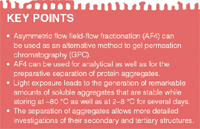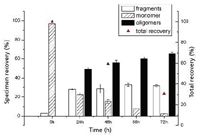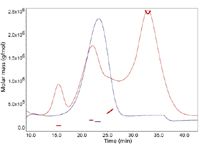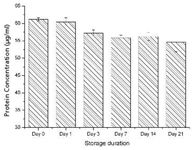The Preparative Use of Flow Field-Flow Fractionation
Demonstrating that flow field-flow fractionation can separate protein aggregates for preparative and analytical purposes.
Proteins — especially monoclonal antibodies — have become increasingly important in the pharmaceutical and biopharmaceuticals sectors. However, there are some fundamental differences between chemically synthesized drugs and proteins and natural ones. Because of the complex and weak structure of the proteins, even a slight change in the environmental conditions, such as pH value, temperature or mechanical stress, may lead to aggregation and often a loss of activity and/or stability. Analysis of a specific aggregate species in a formulation in the presence of the coexisting monomeric protein is challenging. A separation of the species of interest before analysis is preferred because a detailed investigation of a fraction would be much easier and provide a clearer insight into the properties of the aggregates. This article demonstrates that asymmetric flow field-flow fractionation (AF4) can be used as a preparative tool to separate aggregates from a stressed protein formulation. The obtained fractions are shown to be stable during storage at –80 °C and 2–8 °C for several days, thus enabling further investigations of different separated species.
The pharmaceutical use of monoclonal antibodies (MAb) and related protein preparations has increased considerably in the past decade.1,2 It is commonly known that proteins are prone to aggregation. Protein formulations face a variety of stress situations such as shifts in temperature and pH, shaking and shear stress, and light exposure during biopharmaceutical production, transport and storage. In addition, additives, buffer composition, ionic strength and solvent composition can potentially induce the formation of different species of protein aggregates.3 The undesired administration of aggregates within an antibody formulation to a patient, can alter the pharmacological profile of the drug, and potentially lead to more pronounced side effects or cause an adverse immunoresponse in the patient.4 Thus it is crucial to identify and develop suitable analytical methods for the detection of proteins aggregates that also allow for sizing, quantification and separation. The need for such methods is determined by the complex structure of proteins, their instabilities and multiple interactions. Hence, the selection of appropriate analytical methods is of great importance to monitor the protein conformational state.

In this study, asymmetrical flow field-flow fractionation (AF4) was chosen as an analytical tool for the separation of aggregates. AF4 is an increasingly popular analytical method for sizing and quantification of different aggregate species within protein samples.5 In comparison to the "gold-standard" gel permeation chromatography (GPC), no solid phase is needed for the separation. Therefore, AF4 is distinguished from GPC and reversed phase high performance liquid chromatography (RP-HPLC) by lower pressures, much lower shear forces and very small surface areas. These small surface areas are a major advantage of AF4, because interaction of the analytes with the surface is minimized. Therefore, possibly occurring structural changes in the analytes and substantial losses of their amounts are reduced. Furthermore, field-flow fractionation is capable of separating particles spanning from several nanometres to the micrometre range.6
The aim of this investigation was to use the AF4 technology as a complementary method to GPC to quantify and separate fragments, monomer and soluble oligomers of a protein.
Experimental
A recombinant monoclonal antibody was used as a model protein. To generate several protein species in the antibody formulation, different methods to stress the solution were investigated. Exposure of the samples to light for several days using a xenon lamp (Suntest CPS, Heraeus, Hanau, Germany) was found to be the most suitable condition for this experimental approach. Various amounts and types of aggregates can be generated depending on the incubation time. Initially, with increasing duration of light exposure the amount of aggregates and fragments in solution separated by AF4 increases.

Figure 1: Distribution of soluble protein species of a monoclonal antibody formulation detected by GPCâUV. The increasing amount of oligomers is accompanied by a loss in total recovery.
However, the amount of soluble aggregates peaks at a certain point and, subsequently, the formation of insoluble protein species starts. This becomes evident by a sharp reduction of the total recovery in the samples and a strong increase in the number of particles, as shown by light obscuration. The time point of the highest amount of soluble aggregates in the solution depends on several parameters, such as the irradiance, the buffer composition and the concentration of the protein in the sample. Figure 1 depicts the distribution of protein species of a specific monoclonal antibody formulation caused by light exposure. The corresponding numbers are listed in Table 1.

Table 1: Distribution of protein species depending on the duration of light exposure (AF4âUV).
For the investigation in this study, the following conditions were used to generate proper protein samples of an IgG1 monoclonal antibody (MAb1):
- 10 mg/mL protein concentration
- Citrate-phosphate buffer, pH 5.7
- Irradiance 55 W/m2 (±5)
- 48 hours of light exposure.
The AF4 system used for our investigations consisted of an Eclipse 2.0 Separation System (Wyatt Technology Europe GmbH, Dernbach, Germany), equipped with a multi-angle light scattering (MALS), refractive index (RI) and ultraviolet (UV) detector, and a fraction collector. The separation was achieved by using a semi-preparative SP channel with 350 μm in height, 245 mm in length and a width of 50 mm (Wyatt Technology Europe) and a phosphate buffered saline (PBS) buffer pH 7.0 as the mobile phase. The ultrafiltration membrane was made of Nadir regenerated cellulose with a 10 kDa cut-off (Wyatt Technology Corporation, Santa Barbara, USA). The channel flow was set to 1 mL/min, whereas the cross flow was set at 3 mL/min for 5 min followed by a linear reduction to 0 mL/min over a period of 20 min. Finally, 30 min of elution without any cross flow were added. 100 μL of stressed antibody sample were injected per run, equalling a total amount of 1 mg of protein injected to the channel. For separation a Gilson FC-203B fraction collector (Gilson, Inc., Middleton, USA) was connected to the system. The fractions were collected in tubes made of glass.
Although a large amount of 1 mg protein was initially loaded onto the channel, the dilution of the sample during the separation process in the system and the collection of only a particular fraction require a concentration step following the separation. Pierce concentrators (Pierce Biotechnology, Rockford, USA) were used for that approach. These disposable centrifugal devices contain a membrane made of regenerated cellulose as a filter. The membrane of the concentrators used in this study has a molecular weight cut off of 9 kDa, and each tube has a capacity of 7 mL. According to the manufacturer's instruction, a pre-rinsing step was carried out by adding 2 mL of PBS to the tube, followed by a 5 min centrifugation step at 4000 × g. The concentration was performed by pouring the sample in the upper chamber of the concentrators and spinning the tubes in swinging buckets at 4000 × g and 4 °C for 30 min.
Concentration measurements of the samples were performed by UV absorbance at 280 nm, or using a Micro-BCA Assay (Pierce Biotechnology, Rockford, USA).
Results and Discussion
AF4 analysis of MAb1 after 48 hours of light exposure: The fractogram in Figure 2 shows three different peaks and a small shoulder for the IgG1 sample exposed to light for 48 h compared with the native protein sample. The first eluting peak represents fragmented protein species, the second peak represents the remaining fraction of monomer, and it shows a shoulder presumably ascribed to the dimer. The last peak represents the soluble oligomers. The molecular weights were detected by an 18-angle MALS detector, and the refractive index (RI) increment dn/dc was adjusted to 0.185 mL/g (Table 2).

Figure 2: UV 280 nm fractograms and MALS detection of light exposed MAb1 (red line) and native MAb1 (blue line).
The main objective was to separate the oligomer peak from the other protein species in the sample, and check the stability of the separated fraction during storage. Collection of the oligomer peak was carried out for 8 min between retention times 28 and 36 min, at a detector flow-rate of 1 mL/min to achieve a high yield of protein in the fraction. The initial protein concentration was determined via a micro-BCA assay. Approximately 60 (±5) μg/mL of protein was detected in the oligomer fraction. Based on the detector flow-rate and collection time the estimated total amount of protein was 440–520 μg. Data was additionally analysed with Astra Software 5.3.2.22 (Wyatt Technology Europe), and it supported the results obtained from micro-BCA Assay.

Table 2: Molecular weight of the detected species of MAb1.
After separation the crucial question of sufficient stability of the separated fraction had to be faced, especially if the sample was stored in the refrigerator or deep freezer for further investigations.
First, the glass tubes were stocked in the fridge for up to three weeks. At each predefined time point a triplicate of 200 μL sample was removed for the micro-BCA assay performance.
Storage at 2–8 °C did not significantly alter the protein concentration in the separated oligomer fraction within three weeks (Figure 3).

Figure 3: Determination of protein concentration of separated oligomer peak by micro-BCA assay during storage at 2â8 °C.
From these findings, adsorption of the protein to the glass surface of the tube appeared to be negligible.
The samples also underwent to a freeze-thaw cycle. They were stored for several days in the deep freezer (–80 °C) and were subsequently unfrozen in the refrigerator at 2–8 °C. The protein concentration remained stable (data not shown), which suggests that short-term storage of the fraction seems to be possible. The constant protein concentration also indicates that adsorption to the glass surface and precipitation did not occur at a considerable extent.
To assure that the aggregates did not disaggregate after separation, 100 μL of the separated fraction was reinjected in the AF4 system immediately after fractionation. A peak was observed at the same retention time found for the aggregate peak in the stressed sample. The absence of other peaks, for example, fragments or the monomer, also confirmed that the soluble oligomer remained stable during AF4 analysis, despite dilution in the system (data not shown).
Dilution occurring in FFF causes a very low signal-to-noise ratio (S/N) after reinjecting the 60 μg/mL sample, although the focusing step allows the sample to be concentrated after reinjection. Additionally, spectroscopic methods for structural investigations on the protein usually require higher protein concentrations. Protein concentrations of about 200 μg/mL could consistently be achieved. The total recovery determined after the procedure was between 75–85%. By increasing the spinning time, the efficiency could be enhanced to 1 mg/mL after 60 minutes.
With the described approach, suitable concentrations of the separated protein species can be obtained for further investigations.
Conclusions
AF4 is a valuable method to analyse and characterize protein aggregates. Using the new semi-preparative channel and combining it with a fraction collector, FFF is now applicable as a semi-preparative system as well, maintaining its advantages compared with GPC. The major benefit of AF4 is the separation principle, which is independent of a packed stationary phase. That implicates minor shear stress and marginal interactions of the analytes with solid phases. The semi-preparative channel enables separation of protein in the milligramme range and no complex upgrading of the instrumentation for standard AF4 is necessary for this approach.
The studies described in this paper are only dealing with the separation of a most abundant oligomer peak of a monoclonal antibody generated by light exposure. Further investigations might be useful to transfer the method to other protein species, generated under other stress conditions. With such an approach more detailed investigations of the fractions shall be possible. It would be also of major interest to analyse the secondary and tertiary structure of separated fractions by other techniques such as Fourier Transform Infra-red (FTIR), conductivity detector (CD) and fluorescence spectroscopy (FS). With a separation method, it is in fact possible to solely compare different aggregates without the most abundant monomeric form in the mixture.
The use of the concentrators led to concentrations in the upper μg/mL range, depending on the centrifugation conditions. It was shown that the concentration in the fraction remained stable because adsorption or precipitation did not occur within the first days of storing.
The disaggregation behaviour might also be investigated in more detail, based on literature showing that protein aggregates tend to gain equilibrium during storage.7 During a longer period of time and other storage conditions, the fractographic pattern of the fraction might change as well. This will be a subject of further investigation.
Acknowledgements
The authors would like to thank Wyatt Technology Europe GmbH for kindly providing the semi-preparative channel.
Angelika Juliane Freitag is a PhD student in Professor Gerhard Winter's group at the Ludwig-Maximilians University in Munich.
Julia Myschik is a postdoctoral fellow in Professor Gerhard Winter's group at the Ludwig-Maximilians University in Munich.
Katharina Wittmann is studying Pharmaceutical Sciences (MSc) at Ludwig-Maximillians University in Munich.
Gerhard Winter is professor of Pharmaceutical Technology and Biopharmaceutics at the Ludwig-Maximillians University in Munich.
References
1. G. Walsh, Eur. J. Pharm. Biopharm., 55(1), 3–10 (2003).
2. M Berger, V. Shankar and A. Vafai, Am. J. Med. Sci., 324(1), 14–30 (2002).
3. W. Wang, Int. J. Pharm., 289(1–2) 1–30 (2005).
4. A.S. Rosenberg, Aaps J., 8(3), E501–E507 (2006).
5. W. Fraunhofer and G. Winter, Eur. J. Pharm. Biopharm., 58(2), 369–383 (2004).
6. J.A. Jonsson, Field-Flow Fractionation Handbook, edited by: Martin Schmpf, Karin Caldwell and J. Calvin Giddings. Vol. 20. 2001. xii.
7. S. Kiese et al., J. Pharm. Sci., 99(2), 632–644 (2010).

Retaining Talent in Field-Flow Fractionation: An Initiative
The authors present their motivation for establishing the Young Scientists of FFF (YSFFF) initiative within the FFF community.
Separating Impurities from Oligonucleotides Using Supercritical Fluid Chromatography
February 21st 2025Supercritical fluid chromatography (SFC) has been optimized for the analysis of 5-, 10-, 15-, and 18-mer oligonucleotides (ONs) and evaluated for its effectiveness in separating impurities from ONs.












